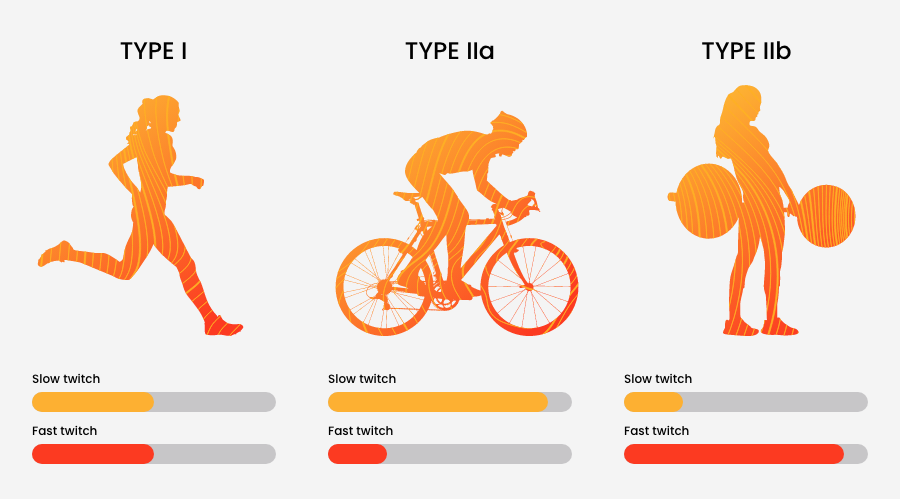
Athletics
Fast Twitch vs Slow Twitch Muscle Fibres: Training Tips
1 min read
Published on
January 2, 2024
Written by
EDGE
Share this article
What are Muscle Fibres?
Muscle fibres are the building blocks of muscles. They are long, tubular structures that contain proteins called myofilaments. These proteins interact to produce muscle contractions, which are responsible for generating force and movement in our bodies. There are three major types of muscle fibres in our bodies: slow oxidative (Type I), fast oxidative-glycolytic (Type IIa), and fast glycolytic (Type IIb)[1].
Slow oxidative (Type I) muscle fibres are used for endurance activities, such as running a marathon. These fibres contain a lot of mitochondria, which are responsible for producing energy in the form of ATP. They are also rich in myoglobin, which gives them their red colour and helps to transport oxygen to the muscles.
Fast oxidative-glycolytic (Type IIa) muscle fibres are used for activities that require both endurance and power, such as cycling or swimming. These fibres contain a lot of mitochondria and are able to produce energy both aerobically (using oxygen) and anaerobically (without oxygen).
Fast glycolytic (Type IIb) muscle fibres are used for activities that require short bursts of power, such as sprinting or weightlifting. These fibres have fewer mitochondria and rely on anaerobic metabolism to produce energy. They also fatigue more quickly than other types of muscle fibres[2].
Everyone has a mix of these muscle fibres in their bodies, but the proportions can vary depending on age, genetics and training. For example, endurance athletes, such as marathon runners, tend to have a higher proportion of slow oxidative (slow twitch) muscle fibres, while power athletes, such as sprinters, tend to have a higher proportion of fast glycolytic (fast twitch) muscle fibres.

How to Train Fast Twitch Muscle Fibres
Fast twitch muscle fibres are responsible for quick, explosive movements. They are essential for athletes who require speed and power, such as sprinters and weightlifters. If you want to improve your fast twitch muscle fibres, you should focus on high-intensity, explosive exercises that recruit these fibres.
Here are some training tips that can help you develop your fast twitch muscle fibres:
-
Lift heavy weights with low repetitions: Lifting heavy weights with low repetitions is one of the most effective ways to build fast twitch muscle fibres. This type of training puts a lot of stress on your muscles, forcing them to adapt and grow stronger. When lifting weights, make sure to choose a weight that is heavy enough to challenge you, but not so heavy that you sacrifice proper form. Aim for 3-4 sets of 8-12 reps.
-
Perform plyometric exercises: Plyometric exercises are explosive movements that involve jumping and landing, such as box jumps and jump squats. These exercises are great for developing fast twitch muscle fibres because they require a lot of power and force.
-
Include sprint intervals in your cardio training: Sprinting is one of the best ways to improve your fast twitch muscle fibres. Sprint intervals involve short bursts of all-out effort followed by periods of rest. This type of training can help you build speed and power, and it can also improve your cardiovascular fitness.
-
Do explosive Olympic lifts: Olympic lifts are complex movements that require a lot of skill and technique. However, they are also great for developing fast-twitch muscle fibres. Olympic lifts such as power cleans and snatches involve explosive movements that require a lot of power and force. If you're new to Olympic lifting, make sure to work with a qualified coach who can teach you proper form and technique.
-
Incorporate isometric exercises: Isometric exercises involve holding a static position for an extended period of time - focusing on the contraction of the muscle. These exercises can help you develop fast twitch muscle fibres by increasing your muscle endurance. Some examples of isometric exercises include wall sits, planks, and static lunges.
By incorporating these training tips into your workout routine, you can improve your fast twitch muscle fibres and become stronger, faster, and more explosive.
Why is it Important to Train Fast Twitch Fibres?
Training your fast twitch muscle fibres can improve your athletic performance, increase your explosive power, and enhance your muscle definition. It can also boost your metabolism and help you burn more calories at rest. As men age, muscle mass decreases, making weight training even more important for overall health and wellbeing[3].
How to Train Slow Twitch Muscle Fibres
Slow twitch muscle fibres are responsible for endurance-based activities and are highly beneficial for athletes who engage in activities that require prolonged periods of exertion, such as marathon runners, cyclists, and swimmers. Training these fibres can help improve your overall athletic performance and endurance.
If you want to improve your slow twitch muscle fibres, you should focus on endurance-based exercises that recruit these fibres. Here are some training tips:
-
Low intensity, long duration: Perform low-intensity and long-duration cardio exercises: such as jogging and cycling. These exercises help improve your cardiovascular endurance and increase the number of slow twitch muscle fibres in your body.
-
Low weight, high reps: Include high-repetition strength exercises, such as bodyweight squats and lunges. These exercises help improve the endurance of your slow twitch muscle fibres and increase their ability to resist fatigue.
-
Practice endurance-based activities: Activities like hiking and swimming engage your slow twitch muscle fibres and help improve their endurance and strength.
-
Stretch: Incorporate yoga and stretching into your training routine. Yoga helps improve your flexibility and balance, while stretching helps prevent injury and increases blood flow to your muscles.
-
Use low-impact exercise equipment: Ellipticals and rowing machines provide a low-impact workout that is gentle on your joints and allows you to train your slow twitch muscle fibres without causing injury.
It's important to note that training your slow twitch muscle fibres takes time and consistency. You won't see results overnight, but with regular training and a healthy diet, you can improve your endurance and overall athletic performance.
It’s Not All About Muscle Fibres
Although your muscle composition can impact your performance, it’s not the only variable that you have control over. Your diet, nutrition and hormone balance are also crucial to maintaining and improving your performance. Testing your hormones can reveal the cause of fatigue or lack of strength, such as low testosterone levels.
View our range of blood tests for athletes.
Always listen to your body and avoid overtraining. Rest and recovery are just as important as training, and giving your body time to recover will help prevent injury and improve your performance in the long run.
Does Muscle Fibre Type Affect Sports Performance?
Yes, muscle fibre type can have a significant impact on sports performance. Athletes who compete in activities that require explosive power and quick movements, such as sprinting and jumping, tend to have a higher percentage of fast twitch muscle fibres. Endurance athletes, such as runners and cyclists, tend to have a higher percentage of slow twitch muscle fibres. However, it is important to note that genetics, training, and nutrition also play a significant role in sports performance.
Whether you are an athlete or a fitness enthusiast, understanding the difference between fast twitch and slow twitch muscle fibres and how to train them can help you achieve your fitness goals and improve your overall health. Remember to tailor your training routine to your muscle fibre type and to incorporate a variety of exercises to keep your workouts challenging and engaging.
Blood test for
Male Runner
18 Biomarkers Included
sports doctor review
Results in 2 working days
Flexible subscription
Medically Reviewed

This article has been reviewed by our medical expert
Our expert Dr Thom Phillips works in NHS general practice and has a decade of experience working in both male and female elite sport. He has a background in exercise physiology and has published research into fatigue biomarkers.
Read Next...
Get expert advice to help you improve your results.
Go to our knowledge center
Circadian Rhythms and Exercise
Athletics
Get 10% off your first order
Want regular tips on how to make the most of your results? Join our newsletter and we'll give you 10% off your order!


